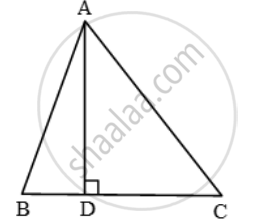Advertisements
Advertisements
Question
In a ∆ABC, AD ⊥ BC and AD2 = BC × CD. Prove ∆ABC is a right triangle
Sum
Solution

In right triangles ADB and ADC, we have
`AB^2 = AD^2 + BD^2 ….(i)`
and, `AC^2 = AD^2 + DC^2 ….(ii)`
Adding (i) and (ii), we get
`AB^2 + AC^2 = 2 AD^2 × BD^2 + DC^2`
`⇒ AB^2 + AC^2 = 2BD × CD + BD^2 + DC^2 [∵ AD2 = BD × CD `
`⇒ AB^2 + AC^2 = (BD + CD)^2 = BC^2`
Thus, in ∆ABC, we have
`AB^2 = AC^2 + BC^2`
Hence, ∆ABC, is a right triangle right-angled at A.
shaalaa.com
Is there an error in this question or solution?
